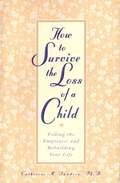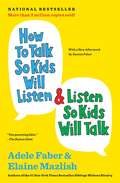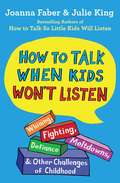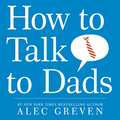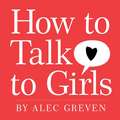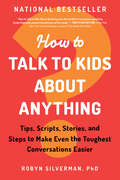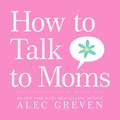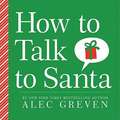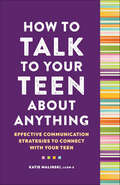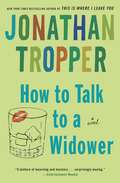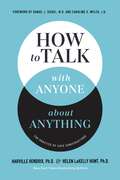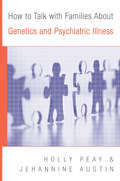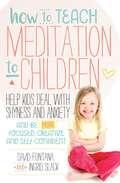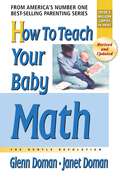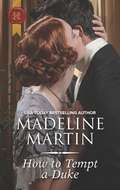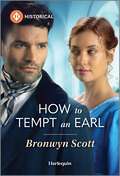- Table View
- List View
How to Survive the Loss of a Child: Filling the Emptiness and Rebuilding Your Life
by Catherine M. SandersIn How to Survive the Loss of a Child, Dr. Sanders, a bereaved parent herself, offers grieving parents practical help and emotional support. This book also helps family members, friends, and caregivers relate to grieving parents and aids them, too, in understanding the process of healing through grief.
How to Take the Ex Out of Ex-Boyfriend
by Janette RallisonSixteen-year-old Giovanna Petrizzo finds it hard enough to fit in. Three years since her family moved to Texas, she's still the newcomer compared to everyone around her. It doesn't help matters when her twin brother, Dante, takes on the mayor's son by running for class president. The least she could expect, though, would be for her boyfriend, Jesse, to support their cause. But Jesse's apparent defection triggers Giovanna's rash emotional side, and before she knows it, she's turned Jesse from the boy of her dreams to the ex boyfriend she dreams of winning back. In her trademark style, Janette Rallison delivers a laugh-out-loud romantic comedy that only leaves readers wanting more.
How to Talk with Your Kids about Sex: Help Your Children Develop a Positive, Healthy Attitude Toward Sex and Relationships
by John T. ChirbanEquips parents to teach their children how to make sexuality a safe, healthy, and sacred part of their lives.How parents address sex--their openness, the context, and their attitudes--will impact how their children view their own sexuality and self-worth. Dr. Chirban helps parents know when, how, and how much, and stresses the vital importance of their role in sex education. He uses humor, compassion, and real-life examples to prepare parents for healthy and ongoing conversations that equips their kids to own their own sexuality and provide an understanding of the larger issues of relationships, love, commitment, and intimacy. In addition, parents discover how helping their children grasp these veiled yet critical keys to a fulfilling life deepens their own connection with their children.With specific helps for children from birth through young adult, Dr. Chirban provides context for what needs to be communicated at each stage of their development as well as tips for the inevitable surprise questions. In addition, he tackles complicated issues such as pornography, relationships and the Internet, sexting, and homosexuality. Most important is the emphasis on strong family values and spirituality as it relates to sexuality.Previously released in 2007 as What's Love Got to Do With It?, this revised book adds new insights from today's culture that make it even more relevant to parents and families.
How to Talk So Kids Will Listen & Listen So Kids Will Talk (The How To Talk Series)
by Adele Faber Elaine Mazlish30th Anniversary Edition Updated with new insights from the next generation You can stop fighting with your children! Here is the bestselling book that will give you the know-how you need to be more effective with your children--and more supportive of yourself. Enthusiastically praised by parents and professionals around the world, the down-to-earth, respectful approach of Adele Faber and Elaine Mazlish makes relationships with children of all ages less stressful and more rewarding. Now, in this thirtieth-anniversary edition, these award-winning experts share their latest insights and suggestions based on feedback they've received over the years. Their methods of communication--illustrated with delightful cartoons showing the skills in action--offer innovative ways to solve common problems. You'll learn how to: * Cope with your child's negative feelings--frustration, disappointment, anger, etc. * Express your anger without being hurtful * Engage your child's willing cooperation * Set firm limits and still maintain goodwill * Use alternatives to punishment * Resolve family conflicts peacefully
How to Talk So Teens Will Listen and Listen So Teens Will Talk
by Adele Faber Elaine MazlishAdele Faber y Elaine Mazlish han ayudado a millones de familias con sus bestsellers. Ahora, y por primera vez en espaÑol, estas aclamadas expertas a nivel internacional nos ofrecen una guÍa que le darÁ las herramientas necesarias para ayudarles a sus adolescentes -- ¡y a usted mismo! -- a sobrevivir la etapa difÍcil de la adolescencia. "Mi hijo de trece aÑos pasa su tiempo con los peores chicos de la escuela. Le paso diciendo que se aleje de ellos, pero siempre me ignora. ¿CÓmo hago para que me haga caso?" "Mi hija pasa mucho tiempo en el Internet charlando con un muchacho de diecisÉis aÑos. Bueno, por lo menos eso dice Él. Ahora la quiere conocer. Ella estÁ muy entusiasmada. Yo tengo miedo. ¿QuÉ hago?" "Acabo de enterarme que mi hija de doce aÑos fuma marihuana. ¿CÓmo la confronto?" Vivir con un adolescente puede ser abrumador. A veces es como si nuestros niÑos cariÑosos se convirtieran de la noche a la maÑana en adolescentes independientes, con sus propios pensamientos, gustos y valores. Hoy en dÍa, los jÓvenes estÁn creciendo en un mundo mÁs cruel, mÁs materialista, mÁs sexual y mÁs violento que antes. ¿QuÉ se debe hacer? Tras muchos aÑos de investigaciÓn, conferencias y comentarios que han recibido, Faber y Mazlish, autoras del clÁsico bestseller CÓmo Hablar para que los NiÑos Escuchen y CÓmo Escuchar para que los NiÑos Hablen, han desarrollado una innovadora forma de mantener un diÁlogo abierto y respetuoso entre padres y adolescentes, una estrategia que le pone frenos al conflicto, reduce frustraciones y fomenta conversaciones acerca de las drogas, el sexo y otros temas difÍciles y de actualidad. Escrito en el estilo prÁctico y popular de estas galardonadas autoras, y lleno de sugerencias, historias y dibujos, esta guÍa le ayudarÁ a construir una relaciÓn mÁs comunicativa y menos conflictiva con sus adolescentes.
How to Talk When Kids Won't Listen: Whining, Fighting, Meltdowns, Defiance, and Other Challenges of Childhood (The How To Talk Series)
by Joanna Faber Julie KingAn all-new guide from the mega-bestselling How To Talk series applies trusted and effective communication strategies to the toughest challenges of raising children.For forty years, readers have turned to Adele Faber and Elaine Mazlish&’s How To Talk So Kids Will Listen & Listen So Kids Will Talk, the book The Boston Globe called, &“the parenting Bible,&” for a respectful and practical approach to communication with children. Expanding upon this work, Adele&’s daughter, Joanna Faber, along with Julie King, coauthored the bestselling book, How To Talk So Little Kids Will Listen. Now, Faber and King have tailored How To Talk&’s tried and trusted communication strategies to some of the most challenging childhood moments. From tantrums to technology to talking to kids about tough topics, How To Talk When Kids Won&’t Listen offers concrete strategies for these and many more difficult situations. Part One introduces readers to the How To Talk &“toolbox,&” with whimsical cartoons demonstrating the basic communication skills that will transform readers&’ relationships with children in their lives. In Part Two, Joanna and Julie answer specific questions and share relatable stories, offering practical tools for addressing issues such as homework hassles, sibling battles, digital dilemmas, problems with punishment, and more. Readers can turn directly to any topic of interest and find the help they need, with handy &“reminder pages.&” Through the combination of lively stories from real parents and teachers, humorous illustrations, and entertaining exercises, How To Talk When Kids Won&’t Listen offers real solutions to struggles familiar to every parent, grandparent, teacher, and anyone else who lives or works with children.
How to Talk so Little Kids Will Listen: A Survival Guide to Life with Children Ages 2-7 (The How To Talk Series)
by Joanna Faber Julie KingA must-have resource for anyone who lives or works with young kids, with an introduction by Adele Faber, coauthor of How to Talk So Kids Will Listen & Listen So Kids Will Talk, the international mega-bestseller The Boston Globe dubbed “The Parenting Bible.”For over thirty-five years, parents have turned to How to Talk So Kids Will Listen & Listen So Kids Will Talk for its respectful and effective solutions to the unending challenges of raising children. Now, in response to growing demand, Adele’s daughter, Joanna Faber, along with Julie King, tailor How to Talk’s powerful communication skills to children ages two to seven. Faber and King, each a parenting expert in her own right, share their wisdom accumulated over years of conducting How To Talk workshops with parents and a broad variety of professionals. With a lively combination of storytelling, cartoons, and fly-on-the-wall discussions from their workshops, they provide concrete tools and tips that will transform your relationship with the young kids in your life. What do you do with a little kid who…won’t brush her teeth…screams in his car seat…pinches the baby...refuses to eat vegetables…throws books in the library...runs rampant in the supermarket? Organized according to common challenges and conflicts, this book is an essential emergency first-aid manual of communication strategies, including a chapter that addresses the special needs of children with sensory processing and autism spectrum disorders. This user-friendly guide will empower parents and caregivers of young children to forge rewarding, joyful relationships with terrible two-year-olds, truculent three-year-olds, ferocious four-year-olds, foolhardy five-year-olds, self-centered six-year-olds, and the occasional semi-civilized seven-year-old. And, it will help little kids grow into self-reliant big kids who are cooperative and connected to their parents, teachers, siblings, and peers.
How to Talk to Dads
by Alec Greven Kei AcederaNever underestimate the power of the father! You may think you know all the tricks, but ten-year-old Alec Greven knows that when it comes to dads, you have to be on your toes. Some dads are strict, and some are easygoing, but they all have a good side and a bad side. What you get totally depends on Dad's mood and your attitude. So no matter how old you are or how tight you are with the big guy, trust Alec to help you get down to the bottom of what makes your dad tick. Tips: There is an 80 percent chance your dad will say yes when your mom says no. Video games calm Dad down and put him in a better mood. If you think Dad is going to let you run wild, you are wrong!
How to Talk to Girls
by Alec Greven Kei AcederaAre you smart enough to take over a girl's heart? Leave it to a nine-year-old to get down to the basics about how to win victory with a girl. How to talk to girls is for boys of all ages--from eight to eighty--and the girls they like. So read this book and then you're ready. Good luck! Tips: Comb your hair and don't wear sweats Control your hyperness (cut down on the sugar if you have to) Don't act desperate
How to Talk to Kids About Anything: Tips, Scripts, Stories, and Steps to Make Even the Toughest Conversations Easier
by Robyn Silverman PhDTHE NATIONAL BESTSELLERA step-by-step guide to answering your kids' toughest questions "When people die, where do they go?""Why is her skin darker than mine?""But how does the baby get in there?"Don't panic. While we know that the first step to connecting deeply with our kids is being able to communicate, empathize, and answer their biggest queries, what do you do when that tricky-to-answer question comes out of the blue? Sometimes we just don't know what to say, so we simply change the subject or give a quick, throwaway answer—and hope it doesn't come up again. Dr. Robyn Silverman, host of the How to Talk to Kids About Anything Parenting Podcast, gets it. A child development specialist and mom, she'll stick with you every step of the way. In this book, Dr. Robyn takes you through the whole spectrum of kids' curious questions, giving you the strategies and scripts to prepare you for life's most challenging conversations. That way your kids get age-appropriate information straight from you, their trusted source, rather than from peers, the media, or the internet. You'll learn how to develop calm, well-thought-out answers to tricky questions on subjects including:DeathSexFriendshipDivorceMoneyAnd more!Drawing on the expertise of dozens of well-known experts, Dr. Robyn's decades of working with children and teens, and her personal experience as a mom, How to Talk to Kids About Anything is a vital resource for parents who value having honest, meaningful conversations with their kids. When you just can't find the right words, this book will be your guide to talking to your kids about anything as they grow from toddlers to teens… and beyond.Makes for a thoughtful gift for new parents!
How to Talk to Moms
by Alec GrevenSOMETIMES YOUR MOM SEEMS LIKE THE MOST WONDERFUL WOMAN IN THE WORLD. SOMETIMES YOU THINK SHE IS MEAN AND WANTS TO RUIN YOUR LIFE. REALLY, IT IS BOTH. No matter how well you know your mom, chances are she's got a few tricks up her sleeve. Alec Greven may only be ten, but he will set you straight when it comes to figuring out the most important woman in your life. TIPS: Don't use your shirt as a napkin or Kleenex. Don't bring loose wildlife into the house--ever! Your mom will always love you no matter what. ALEC GREVEN wrote this book when he was nine years old. He has appeared on The Ellen DeGeneres Show, The Today Show, and Inside Edition. Alec is the author of HOW TO TALK TO GIRLS. He lives in Castle Rock, Colorado, with his family.
How to Talk to Moms
by Alec Greven Kei AcederaSometimes your mom seems like the most wonderful woman in the world. Sometimes you think she is mean and wants to ruin your life. Really, it is both. No matter how well you know your mom, chances are she's got a few tricks up her sleeve. Alec Greven may only be ten, but he will set you straight when it comes to figuring out the most important woman in your life. Tips: Don't use your shirt as a napkin or a Kleenex. Don't bring loose wildlife into the house-ever! Your mom will always love you no matter what.
How to Talk to Santa
by Alec GrevenHow do you control your greed, still get what you want, and spread the cheer? Get ready. Santa's almost here! Ten-year-old Alec Greven is the boy to turn to for advice about the jolly guy in the red suit. He knows it's easy to go wild when Santa is on his way and explains how to avoid Santa-trouble. But there's more to Christmas than want, want, want, and Alec reminds us of the greater meaning--giving to others and spreading joy! There is a 99.999999999% chance that you will never catch Santa. My advice is: Don't risk it! Don't whine now--whine later. December 26 is National Whiners' Day. You can be 100 and still believe. ALEC GREVEN is ten years old and is in the fifth grade. He has appeared on The Ellen DeGeneres Show, the Today show, CNN, The Tonight Show with Jay Leno, Good Morning America, and more. He is also the author of HOW TO TALK TO GIRLS, HOW TO TALK TO MOMS, and HOW TO TALK TO DADS. He lives in Castle Rock, Colorado, with his family.
How to Talk to Your Child About Sex: It's Best to Start Early, but It's Never Too Late—A Step-by-Step Guide for Every Age
by Richard Eyre Linda EyreLinda and Richard Eyre stress that it's never too soon-or too late-to start discussing sex and values with your children, and they've got proven strategies to make it easier. For parents who want to go beyond the birds and the bees talk, How to Talk to Your Child About Sex provides thoughtful, clear, specific guidance on when and, most important, how to help children begin to learn and understand sex, love, and commitment from the most positive viewpoint possible.Preliminary "as needed" talks with three-to eight-year-oldsThe age eight Big TalkFollow-up talks with eight-to thirteen-year-oldsBehavior discussions and guidelines with eleven-to sixteen-year-oldsDiscussions of perspective and personal standards with fifteen-to nineteen-year-olds
How to Talk to Your Kids about Your Divorce: Healthy, Effective Communication Techniques for Your Changing Family
by Samantha RodmanExpert advice for discussing divorce with your childrenWritten by Dr. Samantha Rodman, founder of DrPsychMom.com, How to Talk to Your Kids about Your Divorce teaches you how to raise a happy, thriving family in a changing environment. Each page offers expert advice for discussing your decision in healthy and effective ways, including breaking the initial news, fostering an open dialogue, and ensuring that your children's emotional needs are met throughout your separation. With Dr. Rodman's proven communication techniques, you will:Initiate honest conversations where your children can express their thoughtsDiscuss divorce-related topics and answer questions in age-appropriate waysValidate your children's feelings, making them feel acknowledged and secureStrengthen and deepen your relationship with your kidsWhether you're raising toddlers, school-aged children, or young adults, How to Talk to Your Kids About Your Divorce will help your kids feel heard, valued, and loved during this difficult time.
How to Talk to Your Teen About Anything: Effective Communication Strategies to Connect With Your Teen
by Katie MalinskiLearn how to communicate with your teen They want independence but need to know you're there. They need guidance, but they don't want advice. They'll chat with their friends, but not with you. Breaking the wall of silence with your teen can sometimes be difficult, but it's possible to find connection and have really good talks when you know how. This supportive parenting book provides communication tools, advice, and relatable real-life stories that will help you get the conversation started and strengthen your relationship with your teen.What sets How to Talk to Your Teen About Anything apart from other books on parenting teens:Key communication skills—Learn essential communication techniques, including active listening and emotional regulation, and how to deal with communicating in the digital age.Teen parenting 101—Explore what teens want from life and how you can find a balance between discipline, support, and letting go.Recognize your patterns—Understand your patterns, and learn how to set healthy emotional boundaries that will help you prepare for things like sex education (aka "the talk"), and inspire your teen to open up about sensitive topics.Open the lines of communication and bond with them every day using How to Talk to Your Teen About Anything.
How to Talk to a Widower: A Novel
by Jonathan Tropper"Beautifully crafted", "Fantastically funny." "Compulsively readable." Jonathan Tropper has earned wild acclaim---and comparisons to Nick Hornby and Tom Perrotta--for his biting humor and insightful portrayals of families in crisis and men behaving badly. Now the acclaimed author of The Book of Joe and Everything Changes tackles love, lust, and lost in the suburbs--in a stunning novel that is by turns heartfelt and riotously funny.Doug Parker is a widower at age twenty-nine, and in his quiet suburban town, that makes him something of a celebrity--the object of sympathy, curiosity, and, in some cases, unbridled desire. But Doug has other things on his mind. First there's his sixteen year-old stepson, Russ: a once-sweet kid who now is getting into increasingly serious trouble on a daily basis. Then there are Doug's sisters: his bossy twin, Clair, who's just left he husband and moved in with Doug, determined to rouse him from his Grieving stupor. And Debbie, who's engaged to Doug's ex-best friend and manically determined to pull off the perfect wedding at any cost.Soon Doug's entire nuclear family is in his face. And when he starts dipping his toes into the shark-infested waters of the second-time around dating scene, it isn't long before his new life is spinning hopelessly out of control, cutting a harrowing and often hilarious swath of sexual missteps and escalating chaos across the suburban landscape.From the Hardcover edition.
How to Talk with Anyone about Anything: The Practice of Safe Conversations
by Harville Hendrix, Ph.D. Helen LaKelly HuntRelationships everywhere are in crisis due to our inability to talk about "difference" without polarizing. Since objection to difference is the core human problem, we need a skill that helps us connect beyond difference. That's just what New York Times bestselling authors Dr. Harville Hendrix and Dr. Helen LaKelly Hunt offer in their new book: How To Talk With Anyone About Anything. They call it the Safe Conversations Dialogue process, which everyone can learn and teach, that moves all relationships from danger to safety, making connecting possible.For centuries, most of us humans have talked to others in monologues, believing that the world is the way we see it, that what we say about it is the "truth" and we have assumed that everyone sees it "our" way. If they do not, we experience tension and conflict on many levels. On the other hand, few of us have ever listened to others while they are talking and tried to see the world from their point of view while retaining our own perspective. Instead of listening to understand and collaborate about our differences, we tend to replace their perspective with our own. This results in polarization, not only in our personal lives and work environments, but also in the political and religious arenas we inhabit. This has led to anxiety, frustration, anger, violence, and war. Clearly, the world needs a new way to talk that transcends difference and leads to collaboration, co-creation, and cooperation.Getting the Love You Want, teach that the practice of Safe Conversations Dialogue impacts the "physics of the Space Between." Here is what they mean:All of us live in and are a part of an energy field in which everything everywhere is connecting with everything everywhere. This energy field occupies the Space-Between us.When there is safety in the energy field that occupies the Space-Between us, we can connect.When there is anxiety in the Space Between, we defend ourselves. We cannot connect but tend to polarize.Anyone, if they decide to, can restore safety in the Space Between by using a structure conversation skill called the Safe Conversations Dialogue. In How to Talk with Anyone about Anything, Harville and Helen share the wisdom of the Safe Conversations process and the four structured and teachable skills that create safety and connection:Dialogue: Dialogue is two or more people taking turns talking and listening. Monologue is one person talking and expecting everyone else to listen. When two or more people shift from Monologue to Dialogue, they can transform any relationship from conflict to safety, connection and collaboration.Zero Negativity: Negativity disrupts safety and is non-negotiable for safe and thriving relationships. When Dialogue is practiced with Zero Negativity, criticism about what one does not have is replaced with a positive request for what one wants. This transforms conflict into safety and connecting.Empathy: Empathy is the capacity to experience or imagine how another person has gone through life. When Dialogue is practiced with empathy, one can more easily accept the different perspective of another person and maintain one's own perspective without polarizing.Affirmation: Affirmation is valuing another person because they exist rather than for what they have done for you. When Dialogue includes affirmation, the other person experiences themselves as human rather than as an "object" that is valued because of what they do. How to Talk with Anyone about Anything offers the keys to unlocking your ability to connect with others in a new and profoundly different way. And, as more of us hone that ability, together, we can bring about a fundamental shift in society away from our current focus on the "self" and polarization about difference towards safety and true connecti
How to Talk with Families About Genetics and Psychiatric Illness
by Holly Landrum Peay Jehannine Claire AustinAddressing clients' questions and concerns about the role of genetics in mental illness. As we learn more about how our biology and genes can play into the development of a mental health disorder, patients and their families are increasingly seeking answers to tough questions about common risk factors, the likelihood of recurrence, the need for genetic testing, and implications for future generations. A practical, go-to resource for all mental health clinicians, this guide explains just how to address these questions and concerns in a way that's comprehensible and compassionate. Filled with case studies, sample dialogues, and question-and-answer examples, it is an essential roadmap for practitioners, helping them to demystify a complex issue for their clients and equip them with the accurate, reassuring information they need.
How to Teach Meditation to Children: A Practical Guide to Techniques and Tips for Children Aged 5-18
by David Fontana Ingrid Slack Amber HatchThis is a new edition of the classic guide to teaching meditation to children – one of the first and still one of the best in terms of clarity, practicality and usability. Avoiding religious terminology, it's aimed at both parents and teachers and explains the varying techniques for working with children in different age groups (from 5 upward), offering a wide range of easy-to-follow and effective exercises. The book explains the benefits of meditation for children, from relieving shyness, anxiety and tension to reducing hyperactivity, aggression and impatience. Meditation has also proved helpful when treating asthma, insomnia and depression, and in improving concentration, establishing emotional balance and enhancing imagination and creativity. In fact, meditation is one of the best tools we can offer children to help them cope with the intensity of their feelings and ease the pressures in their lives – among family, with friends and at school. It gives even very young children power over their thinking and emotions through enhanced self-understanding and is incredibly valuable in helping adolescents to navigate the emotional peaks and valleys of the transition from childhood to adulthood. The edition will be given a new foreword by a prominent child psychologist, and a design that highlights the exercises and makes the text even easier to navigate.
How to Teach Your Baby Math
by Glenn Doman Janet Doman*** OVER 13 MILLION COPIES SOLD***Time and again, the work performed at The Institutes for the Achievement of Human Potential has demonstrated that children from birth to age six are capable of learning better and faster than older children. How To Teach Your Baby To Read shows just how easy it is to teach a young child to read, while How To Teach Your Baby Math presents the simple steps for teaching mathematics through the development of thinking and reasoning skills. Both books explain how to begin and expand each program, how to make and organize necessary materials, and how to more fully develop your child&’s reading and math potential. How to Give Your Baby Encyclopedic Knowledge shows how simple it is to develop a program that cultivates a young child&’s awareness and understanding of the arts, science, and nature—to recognize the insects in the garden, to learn about the countries of the world, to discover the beauty of a Van Gogh painting, and much more. How To Multiply Your Baby&’s Intelligence provides a comprehensive program for teaching your young child how to read, to understand mathematics, and to literally multiply his or her overall learning potential in preparation for a lifetime of success.The Gentle Revolution Series:The Institutes for the Achievement of Human Potential has been successfully serving children and teaching parents for five decades. Its goal has been to significantly improve the intellectual, physical, and social development of all children. The groundbreaking methods and techniques of The Institutes have set the standards in early childhood education. As a result, the books written by Glenn Doman, founder of this organization, have become the all-time best-selling parenting series in the United States and the world.
How to Teach Your Baby to Read
by Glenn Doman Janet Doman*** OVER 13 MILLION COPIES SOLD ***Time and again, the work performed at The Institutes for the Achievement of Human Potential has demonstrated that children from birth to age six are capable of learning better and faster than older children. How To Teach Your Baby To Read shows just how easy it is to teach a young child to read, while How To Teach Your Baby Math presents the simple steps for teaching mathematics through the development of thinking and reasoning skills. Both books explain how to begin and expand each program, how to make and organize necessary materials, and how to more fully develop your child&’s reading and math potential.How to Give Your Baby Encyclopedic Knowledge shows how simple it is to develop a program that cultivates a young child&’s awareness and understanding of the arts, science, and nature—to recognize the insects in the garden, to learn about the countries of the world, to discover the beauty of a Van Gogh painting, and much more. How To Multiply Your Baby&’s Intelligence provides a comprehensive program for teaching your young child how to read, to understand mathematics, and to literally multiply his or her overall learning potential in preparation for a lifetime of success.The Gentle Revolution Series:The Institutes for the Achievement of Human Potential has been successfully serving children and teaching parents for five decades. Its goal has been to significantly improve the intellectual, physical, and social development of all children. The groundbreaking methods and techniques of The Institutes have set the standards in early childhood education. As a result, the books written by Glenn Doman, founder of this organization, have become the all-time best-selling parenting series in the United States and the world.
How to Tell Stories to Children: And Everyone Else Too
by Joseph Sarosy Silke Rose WestStorytelling is one of the oldest and most essential skills known to humankind, a timeless parenting tool that helps families celebrate life&’s joys, navigate its challenges, and raise healthy, well-adjusted kids. Stories help children manage their emotions, empathize with others, and better understand the complex world we live in. More importantly, storytelling cultivates a rich and meaningful bond between storyteller and listener, building intimacy and trust between parent and child. In this delightful book, Silke Rose West and Joseph Sarosy—early childhood educators with thousands of storytelling hours between them—distill the key ingredients of storytelling into a surprisingly simple method that can make anyone an expert storyteller. Their intuitive technique uses events and objects from your child&’s daily life to make storytelling easy and accessible. By shifting the focus from crafting a narrative to strengthening your relationship with your child, this book will awaken skills you never knew you had. Complete with practical advice, helpful prompts, and a touch of science to explain how stories enrich our lives in so many ways, How to Tell Stories to Children is a must-read for parents, grandparents and educators.
How to Tempt a Duke (Mills And Boon Historical Ser. #3)
by Madeline MartinA lady’s lessons……in temptation!When her almost fiancé proposes to someone else, Lady Eleanor is suddenly the talk of the ton! With her family in financial dire straits, Eleanor must marry before the end of the Season. Secret lessons with Charles, the dashing, infuriating—and devastatingly charming—Duke of Somersville, should help Eleanor shake off her shameful Ice Queen moniker. But how can she tempt a prospective husband when it’s the duke who ignites her desire?
How to Tempt an Earl (Wed Within a Year)
by Bronwyn ScottDrama, danger and daring romance abound in this spicy, forced proximity Regency. From notorious rake… To unexpected protector Kieran Parkhurst has been awarded the title of earl from the Crown—blood money for the loss of his brother. Keen to avenge him, Kieran meets with a mysterious informant promising valuable information, bringing him face-to-face with captivating Celeste Sharpton, the ward of his enemy… Celeste is risking her life to help Kieran, so for her protection, they go to his country estate. Among Kieran&’s close-knit family, Celeste finally feels like she belongs, but can she tempt the guarded earl into believing they have a future when the enemy is closing in?From Harlequin Historical: Your romantic escape to the past.Wed Within a YearBook 1: How to Court a RakeBook 2: How to Tempt an Earl
